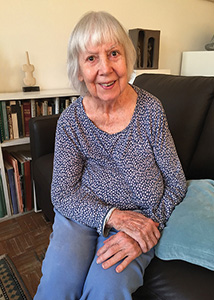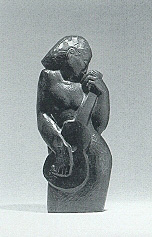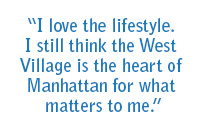 Sculptor Isabel Case Borgatta was born in Madison, Wisconsin in 1921. In her lengthy career, she has had numerous solo and group exhibitions, seen her pieces in museum, corporate and private collections, and been the recipient of numerous awards, among them Yaddo and Edward McDowell Fellowships. Borgatta moved into Westbeth in 1986 and still maintains her studio there.
Sculptor Isabel Case Borgatta was born in Madison, Wisconsin in 1921. In her lengthy career, she has had numerous solo and group exhibitions, seen her pieces in museum, corporate and private collections, and been the recipient of numerous awards, among them Yaddo and Edward McDowell Fellowships. Borgatta moved into Westbeth in 1986 and still maintains her studio there.
When she was 12 years old, Isabel Case Borgatta made a carving in Ivory Soap and won a national prize of $100 in the popular contest sponsored by Procter & Gamble. “One hundred dollars was a big deal in the depths of the Depression and I think I became a sculptor because of that,” she says, laughing. “I started carving anything I could get my hands on. I went from soap to stone! But I think I always had a feeling for form and volume and I liked to make shapes.”
Borgatta went on to attend both Smith College and Yale, from which she graduated with a degree in sculpture. “It’s not the most popular major but it was mine and I loved it,” she says. “And I had a blast! I mean, a girl at Yale? Come on! I was doing what I really loved to do and nobody was holding me back.” After Yale she came to New York and started doing “direct” carving. “That was something new,” she says. “Before that people had built things up in clay models and copied that. I worked directly from a raw piece of stone without preliminary drawings or models.” Since then, Borgatta has shown her work consistently. “I’ve shown pretty much all over the world,” she says. “I’m not a superstar, but I’m up there.”

According to Borgatta, the piece of stone itself is where she finds her inspiration. “Sometimes I have something in mind that I want to carve,” she says. “More often, I find a stone that’s simpatico and I want to work with it. I love the tactile and sensual quality of stone. I can walk into a room with 100 stones and pick out the ones I like very quickly. Something about the shape, size, color, and texture will speak to me. But I’m open to a lot of modifications as I work. I like the fact that stone doesn’t let you make very many mistakes. You can’t put anything back once it’s off. It’s a tough discipline!”
It’s this dedication that sustained Borgatta at a time when women artists were all but ignored by mainstream galleries and museums. “Women artists were not taken seriously when I was starting out,” she says. “They didn’t show women at all! People don’t know that now because there’s been such a change, but the opportunities were just about zero. That’s one reason that I became active in the women’s movement.” Does Borgatta feel she missed opportunities as a result of such misogyny? “No, I feel like I was in the group that helped make a change,” she says. “This is what the organization Women in the Arts was all about: to promote opportunities for women so they could show their work. As a result, so much progress has been made.”
 When Borgatta first moved to New York in the 1940s she lived on Christopher Street. Her marriage to another artist led them to raise their three children in Westchester County and, after separating from her husband, she moved back to the city and subsequently to Westbeth. “To me the Village was always very much like home,” she says. “I liked the scale, the smaller buildings, and the informality. I liked the fact that you could make friends in the neighborhood as well as in your own building. I liked that there were a number of other artists around. I had never completely lost touch with the neighborhood even though I had spent those years in Dobbs Ferry. In fact, I showed at the Whitney way back when it was on 8th Street and now I’m looking forward to going to the new one right around the corner!”
When Borgatta first moved to New York in the 1940s she lived on Christopher Street. Her marriage to another artist led them to raise their three children in Westchester County and, after separating from her husband, she moved back to the city and subsequently to Westbeth. “To me the Village was always very much like home,” she says. “I liked the scale, the smaller buildings, and the informality. I liked the fact that you could make friends in the neighborhood as well as in your own building. I liked that there were a number of other artists around. I had never completely lost touch with the neighborhood even though I had spent those years in Dobbs Ferry. In fact, I showed at the Whitney way back when it was on 8th Street and now I’m looking forward to going to the new one right around the corner!”
As an artist and a resident of Westbeth, Borgatta seems to have found the ideal neighborhood to both live and work in. “I think it’s more tolerant of everybody and everything, more relaxed, less demanding, and more accepting,” she says. “I just feel more at ease here. I love the lifestyle.” She pauses for second. “I still think the West Village is the heart of Manhattan for what matters to me.”
Photo: MDM
